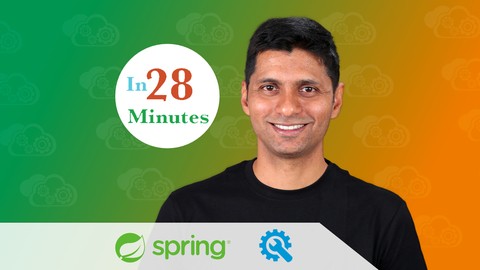
Master Java Web Services and REST API with Spring Boot
Master Java Web Services and REST API with Spring Boot, available at $124.99, has an average rating of 4.54, with 219 lectures, based on 15401 reviews, and has 87287 subscribers.
You will learn about You will Learn to Design and Develop SOAP and RESTful web services with Spring Boot You will Understand the BEST PRACTICES in designing RESTful web services You will Learn the MAGIC of SPRING BOOT – Auto Configuration, Spring Initializr and Starter Projects You will Learn to Connect Web Services to a Database using JPA and HIBERNATE with Spring Boot You will Learn to Implement Exception Handling, Validation, HATEOAS and Filtering for RESTful Web Services. You will Learn to use a wide variety of Spring Boot STARTER PROJECTS – Spring Boot Web, Spring Boot Web Services, Spring Boot Data JPA You will learn how to version, monitor (Spring Boot Actuator) and document (Swagger) your RESTful Web Services with Spring Boot You will understand about WSDL, SOAP Header, SOAP Body, SOAP Fault, XSD, JAXB and EndPoint This course is ideal for individuals who are You want to learn the basics of Web Services or You want to learn the terminology associated with Web Services or You want to learn to develop and design RESTful web services or You want to learn to develop and design SOAP web services or You have good experience with Java and want to see what more you can do with Java or You have good experience with Spring and want to use that knowledge It is particularly useful for You want to learn the basics of Web Services or You want to learn the terminology associated with Web Services or You want to learn to develop and design RESTful web services or You want to learn to develop and design SOAP web services or You have good experience with Java and want to see what more you can do with Java or You have good experience with Spring and want to use that knowledge.
Enroll now: Master Java Web Services and REST API with Spring Boot
Summary
Title: Master Java Web Services and REST API with Spring Boot
Price: $124.99
Average Rating: 4.54
Number of Lectures: 219
Number of Published Lectures: 150
Number of Curriculum Items: 219
Number of Published Curriculum Objects: 150
Original Price: $19.99
Quality Status: approved
Status: Live
What You Will Learn
- You will Learn to Design and Develop SOAP and RESTful web services with Spring Boot
- You will Understand the BEST PRACTICES in designing RESTful web services
- You will Learn the MAGIC of SPRING BOOT – Auto Configuration, Spring Initializr and Starter Projects
- You will Learn to Connect Web Services to a Database using JPA and HIBERNATE with Spring Boot
- You will Learn to Implement Exception Handling, Validation, HATEOAS and Filtering for RESTful Web Services.
- You will Learn to use a wide variety of Spring Boot STARTER PROJECTS – Spring Boot Web, Spring Boot Web Services, Spring Boot Data JPA
- You will learn how to version, monitor (Spring Boot Actuator) and document (Swagger) your RESTful Web Services with Spring Boot
- You will understand about WSDL, SOAP Header, SOAP Body, SOAP Fault, XSD, JAXB and EndPoint
Who Should Attend
- You want to learn the basics of Web Services
- You want to learn the terminology associated with Web Services
- You want to learn to develop and design RESTful web services
- You want to learn to develop and design SOAP web services
- You have good experience with Java and want to see what more you can do with Java
- You have good experience with Spring and want to use that knowledge
Target Audiences
- You want to learn the basics of Web Services
- You want to learn the terminology associated with Web Services
- You want to learn to develop and design RESTful web services
- You want to learn to develop and design SOAP web services
- You have good experience with Java and want to see what more you can do with Java
- You have good experience with Spring and want to use that knowledge
REST API? Yes. Spring Boot ? Yes SOAP ? Yes Best Practices ? Yes Hands-on? Of course.
Do you want to Master Building Great Java Web Services – both RESTful and SOAP – with Spring Boot?
WHAT OUR LEARNERS ARE SAYING:
5 STARS –This is the best course if you like to learnhow REST API exactly works. The instructor is awesome. I had a great time watching his videos and doing coding for this course. It really helped me to do a coding assessment for the company.
5 STARS –This course gave me anexcellent head start with creating Restful web services!
5 STARS –It is such an awesome course, I have now got an idea to createproduction level restful services
5 STARS –As anexperienced JEE developer unfamiliar with Spring Boot and developing web services within it, this wassimply an awesome course for becoming knowledgeable and comfortable in applying it in a real-world context.
5 STARS –This ismy first spring boot course. I’ve thoroughly enjoyed it. Thank you very much Ranga for delivering such ahigh quality course. I’ve learned a lot spring boot from you. If someone want to learn spring boot, this is one of the best courses to pick up.
******* Course Overview *******
Developing SOAP and RESTful web services is fun. The combination of Spring Boot, Spring Web MVC, Spring Web Services and JPA makes it even more fun.
Architectures are moving towards microservices. RESTful web services are the first step to developing great microservices. Spring Boot, in combination with Spring Web MVC (also called Spring REST) makes it easy to develop RESTful web services.
There are two parts to this course – RESTful web services and SOAP Web Services.
In the first part of the course, you will learn the basics of RESTful web services developing resources for a social media application. You will learn to implement these resources with multiple features – versioning, exception handling, documentation (Swagger), basic authentication (Spring Security), filtering and HATEOAS. You will learn the best practices in designing RESTful web services.
You will be using Spring (Dependency Management), Spring MVC (or Spring REST), Spring Boot, Spring Security (Authentication and Authorization), Spring Boot Actuator (Monitoring), Swagger (Documentation), Maven (dependencies management), Eclipse (IDE), Postman (REST Services Client) and Tomcat Embedded Web Server. We will help you set up each one of these.
While the use of SOAP Web Services is on the way down, there are still considerable number of web services using this approach.
In the second part of the course, you will learn the basics of implementing SOAP Web Services developing a few web services for a course management application. You will learn to use a Contract first approach – defining XSD (XML Schema Definition) for your requests and responses. You will learn about WSDL (SOAP Header, SOAP Body and SOAP Fault), XSD (XML Schema Definition) and JAXB (Java API for XML Binding). You will implementing three SOAP web services with exception handling and basic security (with WS Security).
In this part of the course, you will be using Spring (Dependency Management), Spring Web Services , Spring Boot, Spring Security (Authentication and Authorization), Maven (dependencies management), Eclipse (IDE), Wizdler (SOAP Services Chrome Plugin) and Tomcat Embedded Web Server. We will help you set up each one of these.
You will learn
-
What is a Web Service?
-
What is a RESTful Web Service?
-
How to implement RESTful Web Services with Spring and Spring Boot?
-
What are the best practices in designing RESTful Web Services?
-
How to design Resources and GET, POST and DELETE operations?
-
How to implement Validation for RESTful Web Services?
-
How to implement Exception Handling for RESTful Web Services?
-
What is HATEOAS? How to implement HATEOAS for a Resource?
-
What are the different approach in versioning RESTful Services?
-
How to use Postman to execute RESTful Service Requests?
-
How to implement basic authentication with Spring Security?
-
How to implement filtering for RESTful Services?
-
How to monitor RESTful Services with Spring Boot Actuator?
-
How to document RESTful Web Services with Swagger?
-
How to connect RESTful Services to a backend with JPA?
-
What is a SOAP Web Service?
-
What is WSDL (Web Service Definition Language)?
-
What is SOAP Header, SOAP Body and SOAP Fault?
-
What is an XSD (XML Schema Definition)?
-
How to write an XSD for your requests and responses?
-
What is JAXB (Java API for XML Binding)?
-
What is an Endpoint?
-
What is a Contract First approach?
-
What are the different steps in building SOAP Web Services with Spring Web Services & Spring Boot?
-
How to build different SOAP Web services for GetCourseDetailsRequest, GetAllCourseDetailsRequest and DeleteCourseDetailsRequest?
-
How to use Wizdler to execute SOAP Requests?
-
How to implement exception handling for SOAP Web Services?
-
How to implement basic security with WS Security for SOAP Web Services?
COURSE HIGHLIGHTS:
RESTful Web Services
-
Step 01 – Initializing a RESTful Services Project with Spring Boot
-
Step 02 – Understanding the RESTful Services we would create in this course
-
Step 03 – Creating a Hello World Service
-
Step 04 – Enhancing the Hello World Service to return a Bean
-
Step 05 – Quick Review of Spring Boot Auto Configuration and Dispatcher Servlet – What’s happening in the background?
-
Step 06 – Enhancing the Hello World Service with a Path Variable
-
Step 07 – Creating User Bean and User Service
-
Step 08 – Implementing GET Methods for User Resource
-
Step 09 – Implementing POST Method to create User Resource
-
Step 10 – Enhancing POST Method to return correct HTTP Status Code and Location URI
-
Step 11 – Implementing Exception Handling – 404 Resource Not Found
-
Step 12 – Implementing Generic Exception Handling for all Resources
-
Step 13 – Exercise : User Post Resource and Exception Handling
-
Step 14 – Implementing DELETE Method to delete a User Resource
-
Step 15 – Implementing Validations for RESTful Services
-
Step 16 – Implementing HATEOAS for RESTful Services
-
Step 17 – Overview of Advanced RESTful Service Features
-
Step 18 – Internationalization for RESTful Services
-
Step 19 – Content Negotiation – Implementing Support for XML
-
Step 20 – Configuring Auto Generation of Swagger Documentation
-
Step 21 – Introduction to Swagger Documentation Format
-
Step 22 – Enhancing Swagger Documentation with Custom Annotations
-
Step 23 – Monitoring APIs with Spring Boot Actuator
-
Step 24 – Implementing Static Filtering for RESTful Service
-
Step 25 – Implementing Dynamic Filtering for RESTful Service
-
Step 26 – Versioning RESTful Services – Basic Approach with URIs
-
Step 27 – Versioning RESTful Services – Header and Content Negotiation Approaches
-
Step 28 – Implementing Basic Authentication with Spring Security
-
Step 29 – Overview of Connecting RESTful Service to JPA
-
Step 30 – Creating User Entity and some test data
-
Step 31 – Updating GET methods on User Resource to use JPA
-
Step 32 – Updating POST and DELETE methods on User Resource to use JPA
-
Step 33 – Creating Post Entity and Many to One Relationship with User Entity
-
Step 34 – Implementing a GET service to retrieve all Posts of a User
-
Step 35 – Implementing a POST service to create a Post for a User
-
Step 36 – Richardson Maturity Model
-
Step 37 – RESTful Services Best Practices
SOAP Web Services
-
Step 01 – Initialize a Spring Web Services application with Spring Boot
-
Step 02 – Overview of creating SOAP Web Service using Contract First Approach
-
Step 03 – Define Request and Response XML Structure
-
Step 04 – Define XML Schema Definition (XSD) for Request – GetCourseDetailsRequest
-
Step 05 – Define XML Schema Definition (XSD) for Respone – GetCourseDetailsResponse
-
Step 06 – More about XML Schema Definition and Implementing XSD Best Practices
-
Step 07 – Introduction to Java API for XML Binding (JAXB) and Configuring JAXB 2 Maven Plugin
-
Step 08 – Configuring an Endpoint for GetCourseDetailsRequest
-
Step 09 – Spring Web Services Configuration – Message Dispatcher Servlet
-
Step 10 – Spring Web Services Configuration – Generating WSDL
-
Step 11 – Using Wizdler to execute SOAP Requests
-
Step 12 – Implementing a service – Course Details Service – backend with in memory array list
-
Step 13 – Implementing SOAP Web Service for GetAllCourseDetailsRequest
-
Step 14 – Quick introduction to different parts of a WSDL
-
Step 15 – Implementing SOAP Web Service for DeleteCourseDetailsRequest
-
Step 16 – Improving the DeleteCourseDetailsRequest – Using an Enum for Status
-
Step 17 – Exception Handling and SOAP Fault Responses
-
Step 18 – Implementing Security for SOAP Web Services with WS Security
Start Learning Now. Hit the Enroll Button!
Course Curriculum
Chapter 1: Getting Started
Lecture 1: DO NOT SKIP: Success Stories of Other Learners
Lecture 2: Introduction to Course & Course Guide
Chapter 2: Introduction To Web Services
Lecture 1: Introduction To Web Services – An Overview
Lecture 2: What is a Web Service?
Lecture 3: Important How Questions related to Web Services
Lecture 4: Web Services – Key Terminology
Lecture 5: Introduction to SOAP Web Services
Lecture 6: Introduction to RESTful Web Services
Lecture 7: SOAP vs RESTful Web Services
Lecture 8: DO NOT SKIP: Join in28minutes Learning Community
Chapter 3: Introduction to Spring Framework in 10 Steps (NOW 16)
Lecture 1: Step 01 – Getting Started with Spring Framework – Goals
Lecture 2: Fastest Approach to Solve All Your Exceptions
Lecture 3: Step 02 – Setting up New Spring Project with Spring Initializr
Lecture 4: Step 03 – Iteration 1 – Building Tightly Coupled GameRunner and MarioGame
Lecture 5: Step 04 – Understanding Tight Coupling
Lecture 6: Step 05 – Iteration 2 – Loose Coupling Level 1 – Interfaces
Lecture 7: Step 06 – Exploring Loose Coupling with Interfaces – PacmanGame
Lecture 8: Step 07 – Iteration 3 – Loose Coupling Level 2 – Spring Framework
Lecture 9: Step 08 – Q1 – Spring Framework – Understanding whats happening in Background
Lecture 10: Step 09 – Q2 – Spring Framework – Understanding Important Terminology
Lecture 11: Step 10 – Q3 – Spring Framework – Does Spring Framework Add Value
Lecture 12: Step 11 – Q4 – Spring Framework – Running Super Contra
Lecture 13: Step 12 – Q5 – Spring Framework – Maven
Lecture 14: Step 13 – Exploring Spring Framework Dependency Injection Types
Lecture 15: Step 14 – Exploring Spring Modules
Lecture 16: Step 15 – Exploring Spring Projects
Lecture 17: Step 16 – Getting Started with Spring Framework – Review
Chapter 4: Introduction to Spring Boot in 10 Steps (NOW 14)
Lecture 1: Step 01 – Getting Started with Spring Boot – Goals
Lecture 2: Step 02 – Understanding the World Before Spring Boot – 10000 Feet Overview
Lecture 3: Step 03 – Setting up New Spring Boot Project with Spring Initializr
Lecture 4: Step 04 – Build a Hello World API with Spring Boot
Lecture 5: Step 05 – Understanding the Goal of Spring Boot
Lecture 6: Step 06 – Understanding Spring Boot Magic – Spring Boot Starter Projects
Lecture 7: Step 07 – Understanding Spring Boot Magic – Auto Configuration
Lecture 8: Step 08 – Build Faster with Spring Boot DevTools
Lecture 9: Step 09 – Get Production Ready with Spring Boot – 1 – Profiles
Lecture 10: Step 10 – Get Production Ready with Spring Boot – 2 – ConfigurationProperties
Lecture 11: Step 11 – Get Production Ready with Spring Boot – 3 – Embedded Servers
Lecture 12: Step 12 – Get Production Ready with Spring Boot – 4 – Actuator
Lecture 13: Step 13 – Understanding Spring Boot vs Spring vs Spring MVC
Lecture 14: Step 14 – Getting Started with Spring Boot – Review
Chapter 5: Introduction to Maven
Lecture 1: Step 01 – Introduction to Maven
Lecture 2: Step 02 – Creating a Spring Boot Project with Maven
Lecture 3: Step 03 – Exploring Maven pom.xml for Spring Boot Project
Lecture 4: Step 04 – Exploring Maven Parent Pom for Spring Boot Project
Lecture 5: Step 05 – Exploring Maven Further
Lecture 6: Step 06 – Exploring Maven Build Lifecycle with a Spring Boot Project
Lecture 7: Step 07 – How does Maven Work?
Lecture 8: Step 08 – Playing with Maven Commands
Lecture 9: Step 09 – How are Spring Projects Versioned?
Chapter 6: Introduction to Gradle
Lecture 1: Step 01 – Getting Started with Gradle
Lecture 2: Step 02 – Creating a Spring Boot Project with Gradle
Lecture 3: Step 03 – Exploring Gradle Build and Settings Files
Lecture 4: Step 04 – Exploring Gradle Plugins for Java and Spring Boot
Lecture 5: Step 05 – Maven or Gradle – Which one to use for Spring Boot Projects?
Chapter 7: SOAP Web Services with Spring and Spring Boot
Lecture 1: SOAP Web Services – An Overview
Lecture 2: Step 01 – Initialize a Spring Web Services application with Spring Boot
Lecture 3: Step 02 – Overview of creating SOAP Web Service using Contract First Approach
Lecture 4: Step 03 – Define Request and Response XML Structure
Lecture 5: Step 04 – Define XML Schema Definition (XSD) for Request – GetCourseDetailsReque
Lecture 6: Step 05 – Define XML Schema Definition (XSD) for Response – GetCourseDetailsResp
Lecture 7: Step 06 – More about XML Schema Definition and Implementing XSD Best Practices
Lecture 8: Spring Boot 3 UPDATES for SOAP Web Services
Lecture 9: Spring Boot 3 UPDATE – JAXB Maven Plugin Configuration
Lecture 10: Step 07 – Introduction to Java API for XML Binding (JAXB) and Configuring JAXB 2
Lecture 11: Step 08 – Configuring an Endpoint for GetCourseDetailsRequest
Lecture 12: Step 09 – Spring Web Services Configuration – Message Dispatcher Servlet
Lecture 13: Step 10 – Spring Web Services Configuration – Generating WSDL
Lecture 14: Step 11 – Using Wizdler to execute SOAP Requests
Lecture 15: Step 12 – Implementing a service – Course Details Service – backend with in memo
Lecture 16: Step 13 – Implementing SOAP Web Service for GetAllCourseDetailsRequest
Lecture 17: Step 14 – Quick introduction to different parts of a WSDL
Lecture 18: Step 15 – Implementing SOAP Web Service for DeleteCourseDetailsRequest
Lecture 19: Step 16 – Improving the DeleteCourseDetailsRequest – Using an Enum for Status
Lecture 20: Step 17 – Exception Handling and SOAP Fault Responses
Lecture 21: Debugging Guide: Next Step
Lecture 22: Spring Boot 3 UPDATE: Spring Web Services Security
Lecture 23: Step 18 – Implementing Security for SOAP Web Services with WS Security
Chapter 8: RESTful Web Services with Spring and Spring Boot
Lecture 1: Step 00 – Creating a REST API with Spring Boot – An Overview
Lecture 2: CODE BACKUP FILES and STEP BY STEP CHANGES : For Reference
Lecture 3: Step 01 – Initializing a REST API Project with Spring Boot
Lecture 4: Step 02 – Creating a Hello World REST API with Spring Boot
Lecture 5: Step 03 – Enhancing the Hello World REST API to return a Bean
Lecture 6: Step 04 – What's happening in the background? Spring Boot Starters & Autoconfign
Lecture 7: Step 05 – Enhancing the Hello World REST API with a Path Variable
Lecture 8: Step 06 – Designing the REST API for Social Media Application
Lecture 9: Step 07 – Creating User Bean and UserDaoService
Lecture 10: Resources for Next Step
Lecture 11: Step 08 – Implementing GET Methods for User Resource
Lecture 12: Step 09 – Implementing POST Method to create User Resource
Lecture 13: Step 10 – Enhancing POST Method to return correct HTTP Status Code and Location
Lecture 14: Step 11 – Implementing Exception Handling – 404 Resource Not Found
Instructors
-
in28Minutes Official
DevOps, Azure, GCP, Docker, Kubernetes, Java & Spring Boot
Rating Distribution
- 1 stars: 181 votes
- 2 stars: 239 votes
- 3 stars: 1533 votes
- 4 stars: 5856 votes
- 5 stars: 7592 votes
Frequently Asked Questions
How long do I have access to the course materials?
You can view and review the lecture materials indefinitely, like an on-demand channel.
Can I take my courses with me wherever I go?
Definitely! If you have an internet connection, courses on Udemy are available on any device at any time. If you don’t have an internet connection, some instructors also let their students download course lectures. That’s up to the instructor though, so make sure you get on their good side!
You may also like
- Best Investing Courses to Learn in March 2025
- Best Personal Finance Courses to Learn in March 2025
- Best Health And Wellness Courses to Learn in March 2025
- Best Chatgpt And Ai Tools Courses to Learn in March 2025
- Best Virtual Reality Courses to Learn in March 2025
- Best Augmented Reality Courses to Learn in March 2025
- Best Blockchain Development Courses to Learn in March 2025
- Best Unity Game Development Courses to Learn in March 2025
- Best Artificial Intelligence Courses to Learn in March 2025
- Best Flutter Development Courses to Learn in March 2025
- Best Docker Kubernetes Courses to Learn in March 2025
- Best Business Analytics Courses to Learn in March 2025
- Best Excel Vba Courses to Learn in March 2025
- Best Devops Courses to Learn in March 2025
- Best Angular Courses to Learn in March 2025
- Best Node Js Development Courses to Learn in March 2025
- Best React Js Courses to Learn in March 2025
- Best Cyber Security Courses to Learn in March 2025
- Best Machine Learning Courses to Learn in March 2025
- Best Ethical Hacking Courses to Learn in March 2025






















